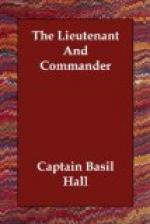Before the party had time to assemble, the delighted Admiral had himself discovered in his own dish three or four small garnets, one ruby, and several small crystals of corundum. By-and-bye, to the astonishment of every one, a collection was made, which not only furnished the promised ring to the governor’s lady, but half-a-dozen others of equal beauty. These precious stones were certainly not of the largest dimensions; but, for all that, the Admiral established his point.
CHAPTER XX.
CEYLONESE CANOES—PERUVIAN BALSAS—THE FLOATING WINDLASS OF THE COROMANDEL FISHERMEN.
The canoes of Ceylon, as far as I remember, are not described by any writer, nor have I met with any professional men who are aware of their peculiar construction, and of the advantages of the extremely elegant principle upon which they are contrived, though capable, I am persuaded, of being applied to various purposes of navigation.
Among the lesser circumstances which appear to form characteristic points of distinction between country and country may be mentioned the head-dress of the men, and the form and rig of their boats. An endless variety of turbans, sheep-skin caps, and conical bonnets, distinguish the Asiatics from the “Toppee Wallas” or hat-wearers of Europe; and a still greater variety exists amongst the boats of different nations. My purpose, just now, however, is to speak of boats and canoes alone; and it is really most curious to observe, that their size, form, cut of sails, description of oar and rudder, length of mast and so on, are not always entirely regulated by the peculiar climate of the locality, but made to depend on a caprice which it is difficult to account for. The boats of some countries are so extremely unstable, and altogether without bearings, that the smallest weight on one side more than on the other upsets them. This applies to the canoes of the North American Indian, which require considerable practice, even in the smoothest water, to keep them upright; and yet the Indians cross immense lakes in them, although the surface of those vast sheets of fresh water is often as rough as that of any salt sea. The waves, it is true, are not so long and high; but they are very awkward to deal with, from their abruptness, and the rapidity with which they get up when a breeze sets in.
On those parts of the coast of the United States where the seasons are alternately very fine and very rough, our ingenious friends, the Americans, have contrived a set of pilot-boats, which are the delight of every sailor. This description of vessel, as the name implies, must always be at sea, as it is impossible to tell when her services may be required by ships steering in for the harbour’s mouth. Accordingly, the Baltimore clippers and the New York pilots defy the elements in a style which it requires a long apprenticeship to the difficulties and discomforts of a wintry navigation,




